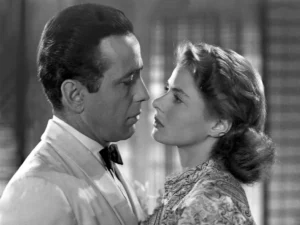Iambic pentameter is a poetic device used in traditional English poetry and verse drama. It adds beauty, rhythm, and a unique beat while reading a poem. In a way, iambic pentameter has become a poetic tool of olden days, has it? Let’s check out this article.

With examples from Shakespeare, The Meyerowitz Stories, and some of hip-hop’s renowned artists, we will break down iambic pentameter so you may apply distinct literary “foot” to your cinema dialogue in new and fascinating ways. But first, let’s go through what makes iambic pentameter.
Video: Shakespeare’s Love for Iambic Pentameter
What is Iambic Pentameter?
Iambic pentameter is a rhythm form that uses unstressed and stressed syllables in five groups. It is most typically used in poetry. The most well-known meter for iambic poetry is pentameter, but there are others: dimeter, trimeter, tetrameter, and so on. The flow provided by this iambic meter was a favorite of William Shakespeare’s in his plays and poems.
Its aim, as complicated as it may appear, is relatively straightforward. Consider this: iambs have the same rhythm as a heartbeat – da-DUM, da-DUM, da-DUM — one unstressed, one stressed word.
For thousands of years, poets have employed iambic poetry to track the most fundamental of all rhythms: our heartbeat (in pairs of five). There is a reason Shakespeare is regarded as the most excellent writer of all time by many. Metaphors, subtext, and great flow abound throughout his writing. This rhythm was one of his favorite writing tools, and it was present in many of his best works.
Nowadays, we examine Shakespeare’s plays from the perspective of history, attempting to understand the complexities of his style. Iambs are something we all understand intuitively, but they’re not always easy to express.
Take, for example, Hamlet’s famous remark “to BE, or NOT to BE.” Watch James Franco and Tommy Wiseau attempt to master syllabic emphasis.
Video: The Disaster Artist Trailer
The whole quotation, “to BE, or NOT to BE, that IS the QUES-tion,” has eleven syllables, which is one too many for it to be classified as iambic pentameter. In the first portion, the iambs are great — think da-DUM, da-DUM, da-DUM — but there’s just one too many in the second part.
History of Iambic Pentameter
Latin poems have lines of ten syllables each. It’s usually assumed that a line of this length, maybe in Alcmanian meter, inspired the ten-syllable line of some Old French chansons de geste like Roland’s Song. After the fourth word, such Old French lines always had a caesura. However, the troubadours of Provence, particularly Cercamon, Bernart de Ventadorn, and Bertran de Born, used this line with more flexibility in the 12th century. The tenth syllable of the line was emphasized in both Old French and Old Provençal, and feminine ends were popular, making the line eleven syllables.
As most Italian words have feminine endings, authors like Giacomo da Lentini, Boccaccio, Petrarch, and Dante adopted this line, often using the eleven-syllable version (endecasillabo). In addition, they frequently used a pattern in which the fourth (usually accented) and fifth (typically unaccented) syllables were combined into a single word, in contrast to the Old French line, which required a stop after the fourth syllable. This pattern became known as “typically Italian.”
Iambic Pentameter in our Lives
You may believe that iambic pentameter is a relic of a bygone era, but this is not the case. Even though few modern writers arrange their works in iambic pentameter, many do so from time to time for dramatic effect.
Take my word for it, or listen to Akala, a rapper and Shakespeare scholar, explain:
Video: Akala on Iambic Pentameter
Iambs have been used to structure bars by some of hip-most hop’s iconic artists, including Jay-Z, Eminem, and Wu-Tang Clan. It’s something we all do to match emphasis to emotion in conversation. Consider the following question: who is preSENT? And how we employ linguistic focus to achieve a communicative goal. Writing and rapping are both examples of this.
Remember that iambic poetry is ideal for preserving a heartbeat’s rhythm — ba-DUM, ba-DUM, ba-DUM. The following video delves deeper into the technical features of iambic pentameter.
Video: Iambic Pentameter Explained
We have looked at how writers use iambs, but it’s also worth considering their opposites. An iamb is defined by an unstressed syllable that leads directly into a stressed syllable, whereas a trochee is characterized by a stressed syllable that leads into an unstressed syllable.
How to Write in Iambic Pentameter?
If you are not sure how to write in iambic pentameter, consider this: what is the point of writing in iambic pentameter in the first place? The solution is straightforward: iambic pentameter is an iambic rhythm meter whose objective is to maintain an “ear-pleasing” beat.
Do not get too caught up in the pentameter; iambs can be used in various ways. For example, iambic rhythm can assist screenwriters in maintaining the flow of conversation in their films. One such example is given below:
The dialogue of The Meyerowitz Stories is antithetical to Shakespeare in many ways. It is rough and unpolished, but it serves the same purpose: to retain time and rhythm.
Video: Realistic Film Dialogue in The Meyerowitz Stories
Conclusion
Iambic pentameter might seem outdated as a concept. Still, the examples mentioned above are a testament that as long as there is rhythm – there will be iambic pentameter. It is here to stay. An iambic rhythm is a valuable tool, but it is not the only one. Experiment with several writing styles, such as iambic, trochaic, and flat. You never know what will work best in your conversation.













